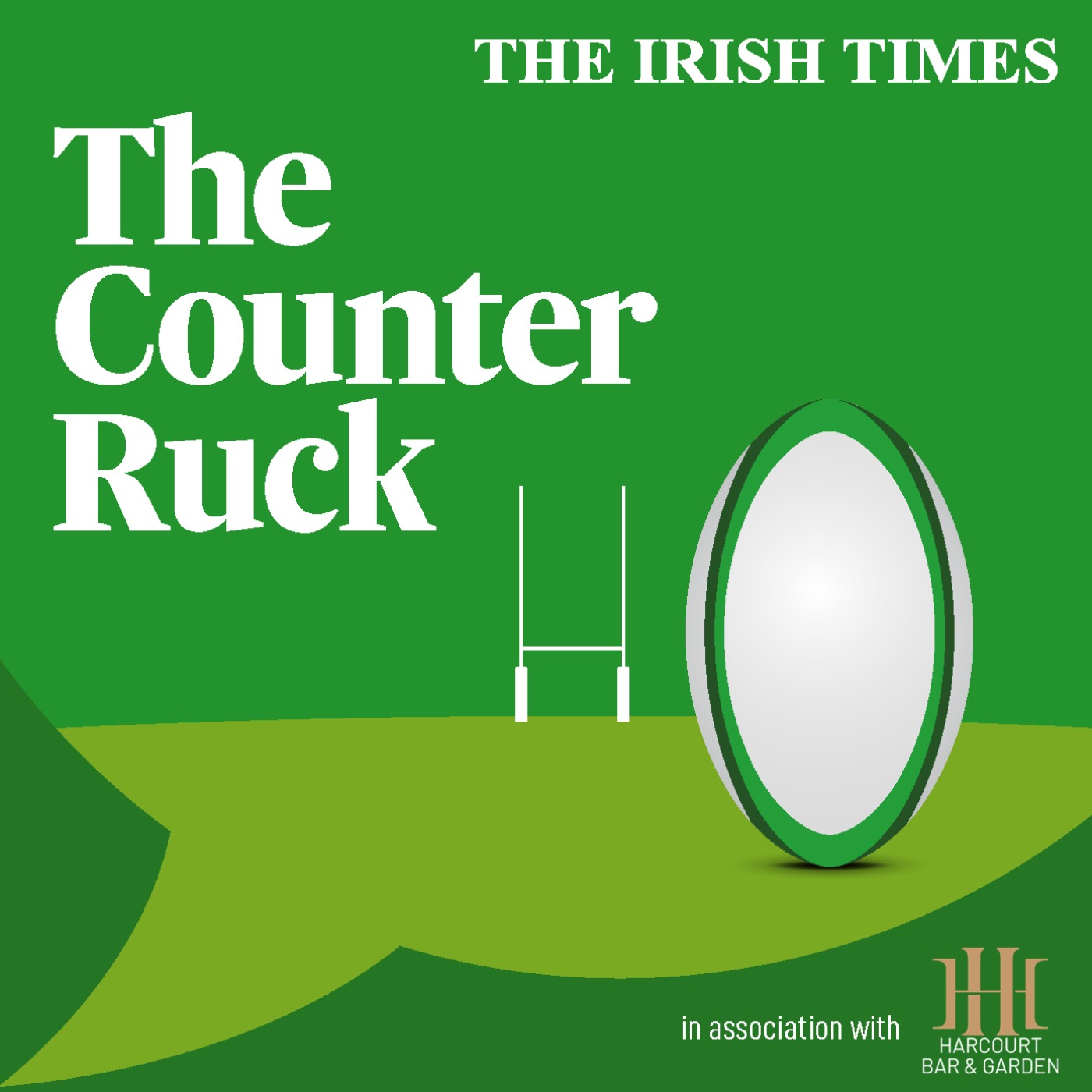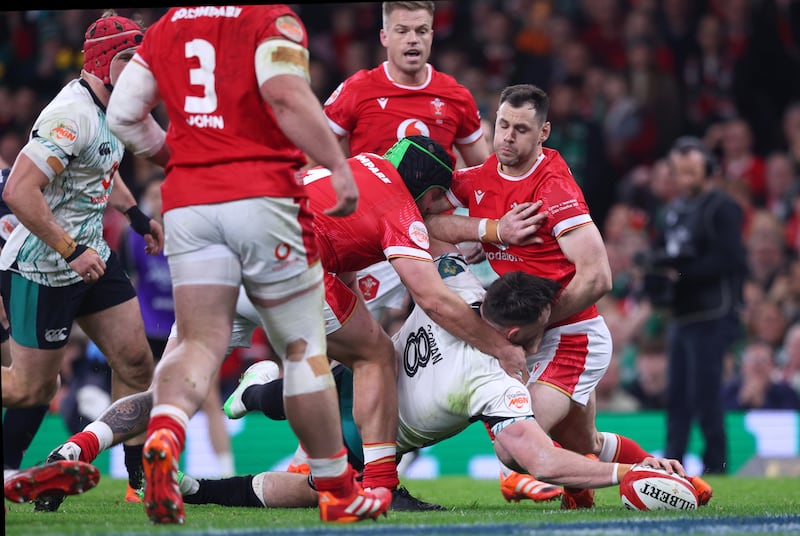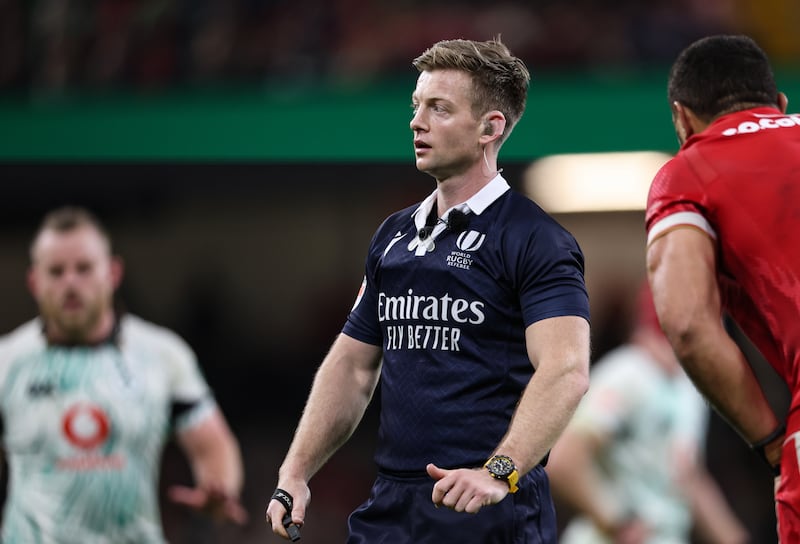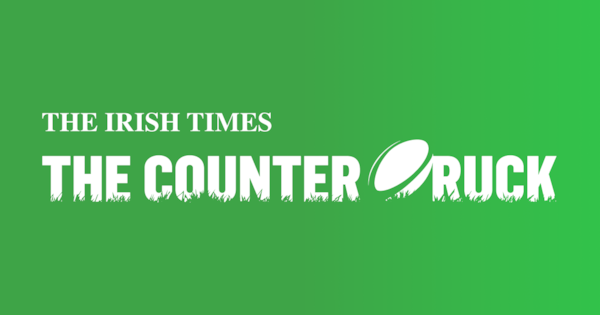Cardiff, the Principality Stadium. “There’s no place on Earth quite like it.”
I’ve said that before, and I’ll probably say it again. If any Ireland players doubted the high degree of difficulty in producing an A-grade performance in this inspiring cathedral of rugby then they will doubt no more. There had been a disquieting sense of entitlement during the week. It was as if the win box was already ticked, and it was just a question of by how much.
Wales were on song, both on the pitch and in the stands. They played all of the rugby, while the men in white, abandoning any cavalier approach of kicking penalties to the corner, kicked for goal. That, and a lot of grit, saved them.

How Ireland escaped Cardiff unscathed
Englishman Christophe Ridley was in charge, and he did well, including some very tight decisions. He was calm, clear in making his calls, and did not chatter away endlessly. It might well be a case of “the king is dead, long live the king” – hands up everybody who missed Wayne Barnes. Sorry, Barnsey, we all get forgotten, and quickly too.
The toughest of calls by the officials needed a forensic examination by the TMO, Ian Tempest, before Wales’ Ellis Mee was denied a try, but only by the width of a blade of grass. Fortune favoured Ireland on this one, but it was the correct call.
It is increasingly worrying that the camera angles we see are confusing, often contradicting each other. Parallax is a true science. In rugby terms it is the “apparent difference” in the position of the ball when viewed along two different lines of sight. Jack Conan’s quite definite try against Scotland was an example, with one camera shot showing the ball short of the line. And for passes, the camera often shows the ball as travelling forward from one angle, and clearly backwards from another. Rugby’s misinformation.

Conan, an immense figure at present, bagged yet another try, but there was more than a hint of good fortune about this one. Jamison Gibson-Park’s lucky stars shone brightly when Ridley judged that the scrumhalf’s fumble at the base of the ruck did not go forward. It was a split second before he passed to Conan, and he could hardly have complained if it had been whistled up. Neither did the referee see anything wrong with Garry Ringrose’s side entry into that same ruck.
As the clock reached the half-hour mark, a reckless tackle attempt by Ringrose saw a nasty head-on-head collision with Ben Thomas. Ridley sent it to Italian official in the bunker, Matteo Lipperini. News came through at half-time of the upgrade to red, and there can be no complaints. Ireland then had to wait just an extra 10 minutes before sending on Bundee Aki under the 20-minute red card replacement experiment. He made a huge difference as to how the match subsequently unfolded.
[ Ireland keep cool in Wales to stay on course for shot at historic Grand SlamOpens in new window ]
Ireland, it has been reported, are not in favour of this law trial being introduced permanently. I trust that they’ll stick to their guns, despite being major beneficiaries on this occasion. Over the past 12 months or so the team has earned plenty of praise in this column for card avoidance by positively altering their tackling technique so as to eliminate head contact. It has not affected their performance, or their results.
But then, along comes the red card replacement and this happens. Coincidence maybe, but also maybe not. This replacement law is not a significant enough deterrent. Lest we forget, rugby has a duty to rid itself of tackles which incorporate a high level of danger. That’s the starting point for concussion and brain damage, with the accompanying potential risks of dementia and chronic traumatic encephalopathy. It was good to see that Irish commentary and punditry was in full agreement with the red card, Nigel Owens and Sam Warburton too, the latter wondering if allowing the replacement was enough to change behaviour. Worryingly, but perhaps not surprisingly, Martin Johnson did not agree.

There was another piece of foul play when Welsh prop Henry Thomas tucked his arm and hit into Andrew Porter at chest level. It certainly wasn’t in red card territory, and perhaps not yellow either. But it did qualify for a penalty, no question. However, on review, Ridley curiously did not judge it as foul play.
The Ireland scrum had another torrid time, and the lack of prop strength in depth ensures that teams will target the Irish set piece. Ridley and his assistants got things as correct as anyone can in this horribly vexed area, but there was a question mark over the very first scrum which saw Ireland penalised. The referee had his arm out as the ball emerged, seemingly playing advantage to Ireland, but then, suddenly, the penalty went to Wales. Unless it was an odd signal for “play on”, it seems Ridley took advice from his far-side assistant, which was strange considering he appeared to have made up his own mind.
We were treated to an amusing little incident late on. Ridley told Tadhg Beirne not to touch the ball, as it was not yet out. Beirne however was already in the process of picking it up, but on hearing the referee’s instruction, he bent down and placed the ball back exactly where he’d got it. I wonder will that ever catch on, probably not.
The Calcutta Cup match is always special, but Scotland – going for five in a row – left Twickenham for home without it. Referee Pierre Brousset had done quite well, but then came his last-minute intervention following Duhan van der Merwe’s try. All that was needed was for Finn Russell to convert it to take the cup back across the border. Mysteriously, erroneously, the referee moved the position of the kick about two metres further out towards the touchline, rather than opposite the place of the touchdown.
Russell pulled the kick slightly, just wide of the near post, and by less than those two metres.
Why Brousset got involved in this, we will never know. And, I imagine, neither will he. However, nightmares won’t be out of the question.

















